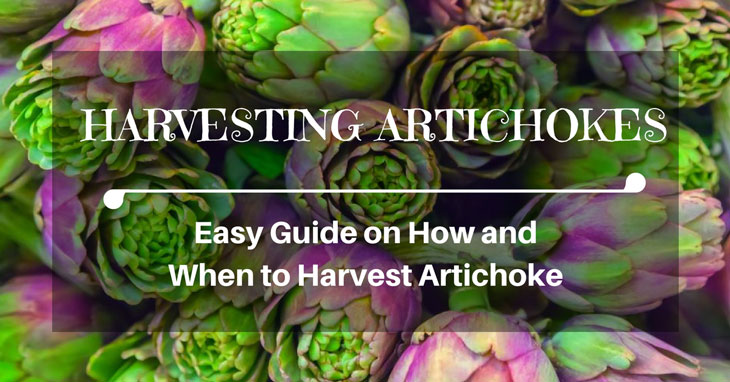Easy Guide on How and When to Harvest Artichoke
Artichokes are considered by many as a delightful treat. They are quite versatile in the kitchen as you can add them in a variety of dishes. They are also known to contain vitamins, minerals and cancer inhibitors. However, one of the interesting things about artichokes is that they become inedible when not harvested at the right time.
One of the critical parts of cultivating artichokes is identifying the right timing to harvest the edible parts. You also must do it the right way. If it is your first year to cultivate artichoke, this guide will be helpful to you. We will show you just how and when is the perfect time to harvest artichokes.
More...
What is Artichoke?
Artichoke is a member of the sunflower family and is actually considered a perennial thistle. They are first introduced in the US and the rest of the Americas by French and Spanish gardeners. They grow best in places with frost-free winters and where the weather is cool and foggy in the summer. They are now widely cultivated in the coastal regions of California where the conditions are favorable for them.
It can be difficult to describe how artichokes really taste like. Some liken them to an eggplant which is tender, soft and juicy but is just a bit sweeter. It also has a milder taste like that of asparagus or celery. Some people say artichokes taste like Brussel sprouts but without any bitterness. You can also taste a hint of lemony taste.
There are two common types of artichokes cultivated in the US. These are the Globe (rounded) and the Violetta (long and tapered). Artichokes can grow as high as 5 feet. They bear flower buds that look more like dark green pinecones with a diameter of about 4 inches. This is the edible portion of the plant. However, this part also becomes coarse and barely edible when the flower buds start to bloom. Timing is critical when it comes to harvesting artichokes.
Before I would tell you when and how to harvest artichokes, I thought it would be right to share with you first how to grow artichokes. You’ll only be able to get a good harvest if you grow your artichoke plants the proper way.

How to Grow Artichokes?
Artichokes grow best in places where the temperature never falls below 25 degrees Fahrenheit. You also need at least 90 to 100 days of frost-free days. If your place doesn’t meet these requirements, don’t despair. If you live in cooler areas than USDA Zone 8, you could treat artichokes as annuals. That is to grow single season and then harvest the buds and replant again every year.
Generally, artichokes are grown from crowns because it is quicker than growing from seeds. It is important to note that artichoke plants are heavy feeders.
When planting, you need to dig deep and add a shovel full of compost in the hole before putting in the crown. Plant them about 4 to 5 feet apart in your home garden. Perennial artichokes can branch out up to about 5 feet so they need to be planted apart to give room for the leaves to spread out.
Once planted, you need to keep the bed of the plant weed free. Mulching can help prevent weeds. The mulch will also keep the soil moist and the roots cool which is just the way artichokes love.
As part of maintaining the plant, be sure that your artichokes get a full sun and plenty of water. Adequate watering makes the artichoke buds grow tender At the same time, be sure that the soil is well drained.

When to Harvest Arichoke - Right Time to Harvest
Artichoke buds are generally harvested when they reach full size. That is before the buds begin to spread and open to bloom flowers. If you wait too long, the bud will lose its tenderness and become fibrous and stringy which is impossible to eat.
Generally, the harvest season for artichokes begins in late July and it continues until the beginning of frost. For artichokes that are planted in the fall, harvesting is done as spring.Each stem of an artichoke plant forms several flower buds. The buds normally start to form on top of tall stems. Check your plant regularly as soon as the buds start to form. You’ll know it’s the right time to harvest when:
- The bud is tight and firm
- The petals have not yet opened
If your plant grows under ideal conditions, the center bud could grow at least 3 inches and up to 4 inches in diameter. In a cluster of buds, the center one normally ripens first. Once you harvest that, it is normal for side shoots to develop. You need to harvest the side shoots upon meeting the conditions above, but don’t expect for them to grow as large as the center bud.
How to Harvest Artichokes
After months of waiting, when the time is ripe, you can now harvest your artichoke buds. All you need for harvesting is a sharp knife and a container where you will put your harvest. It is important to note that artichokes bruise easily so it is important to handle them very carefully.Here is how to harvest the artichoke buds:
1. Check if the flower bud is ready for harvest. When it is, don’t cut the bud right at its base. Instead, cut it with 1 to 3 inches of stem from the base. This allows you to easily handle the bud while cutting the stem, preventing possible bruises.
2. After harvesting all the buds in a stem, cut the stem completely to the ground. For artichoke plants that are already fully established, you also have to prune the entire plant by a third and continue to nurture the plant to encourage a fall harvest.

Health Benefits of Artichoke
The main reason why many gardeners grow artichoke is that it offers many health benefits. According to Dr. Mercola, artichokes provide 28% of the recommended daily value of dietary fiber and 25 % of recommended daily value of vitamin C or ascorbic acid. In addition, artichokes are also rich in vitamin K which works as an antioxidant. Other minerals present in artichokes are copper, manganese, magnesium, potassium and phosphorus.
Moreover, Dr. Mercola also added that there have been studies conducted to prove the health benefits of artichokes. In one clinical trial conducted in 2011, it shows the negative effects of the extracts from the edible parts of artichokes on breast cancer cells. This indicates that artichokes have cancer-fighting capabilities. Another study conducted by a university hospital in Cleveland shows that artichoke also contains silymarin which is an anticarcinogenic agent.
Culinary Uses for Artichokes
One way to enjoy the health benefits of artichokes is to integrate it in your dishes. To do that, you need to know how to prepare the artichoke:
1. Remove the outer leaves of the artichoke buds.
2. Remove the hair in the center of the bud. The hairs are the thistles and they need to be discarded.
3. What is left is the heart of the artichoke. You can then slice it into half or quarter, depending on the dish you are preparing.
Some of the common ways to integrate artichokes in your diet are:
- Added as a component for casseroles and salads
- Steaming or boiling the heart of the artichoke and then seasoning it with salt and pepper. You can also sautee it with butter
- Marinating and cooking the heart of the artichoke with other vegetables
- Stuffing the heart of the artichoke with bread crumbs and then frying or baking it
- Pickling the heart of the artichoke
Conclusion
Artichoke is a nutritious and versatile vegetable that you can use in many dishes. If you are growing artichoke plants, one of the vital things you need to know is the right timing when to harvest the artichoke buds. If you harvest too early, the buds may not be ripe enough to get that tender and juicy heart. If you harvest too late, the artichoke may no longer be edible. With the above guide, you should be able to harvest your artichoke just when you should.
References:
https://www.gardeningknowhow.com/edible/vegetables/artichoke/growing-artichokes.htm
https://www.gardeningknowhow.com/edible/vegetables/artichoke/how-to-harvest-artichokes.htm
https://bonnieplants.com/growing/growing-artichoke/
http://www.artichokerecipes.co.uk/when-do-i-harvest-my-artichokes/
Do you know of anybody who might benefit from this guide? Please feel free to share. If you want to share your tips in harvesting artichokes, do let me know in the comment section.

